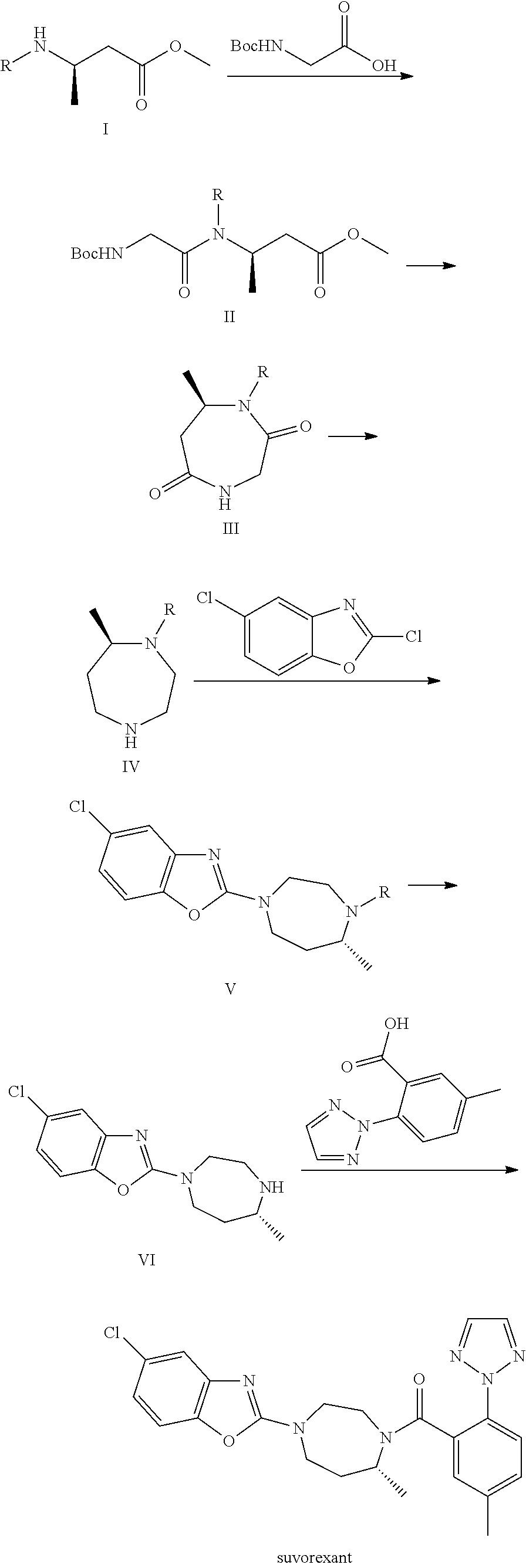Suvorexant intermediate and preparation method thereof
a technology of suvorexant and intermediate, which is applied in the field of pharmaceutical synthesis, can solve the problems of increased cost, low overall yield of the route, and huge waste of materials, and achieve the effects of reducing production costs, high toxicity, and improving the atomic utilization rate of the compound
- Summary
- Abstract
- Description
- Claims
- Application Information
AI Technical Summary
Benefits of technology
Problems solved by technology
Method used
Image
Examples
example 1
Synthesis of (R)-methyl 3-(N-benzyl-2-((t-butyloxycarboryl) amino) acetamido) butyrate
[0066]
[0067](R)-methyl 3-(benzylamino)-butyrate (40 mmol) was added into a flask, dissolved with 80 ml anhydrous DMF; the system was cooled to 0-5° C., added with 1-hydroxybenzotriazole (48 mmol), 1-ethyl-(3-dimethylaminopropyl) carbodiimide hydrochloride (48 mmol), N-methylmorpholine (100 mmol) and N-(t-butoxycarbonyl) aminoacetic acid (44 mmol) with stirring, then reacted at room temperature for 6 h, and added with 10 mass % citric acid solution. The aqueous phase separated was extracted with ethyl acetate. All organic phase was washed with saturated sodium bicarbonate solution followed by saturated brine, dried over anhydrous sodium sulfate and filtered. The solvent was evaporated to dryness, and the residue was recrystallized with ethyl acetate and petroleum ether to obtain (R)-methyl 3-(N-benzyl-2-((t-butoxycarbonyl) amino) acetamido) butyrate with a yield of 93%. 1H NMR (400 MHz, CDCl3) δ 7.3...
example 2
Synthesis of (R)-1-benzyl-7-methyl-1,4-diazepane-2,5-dione
[0069]
[0070](R)-methyl 3-(N-benzyl-2-((t-butyloxycarboryl)amino)acetamido) butyrate (10 mmol) was added into a flask, dissolved with 10 ml methanol, added with 40 ml of 30 mass % of solution of HCl in methanol, and reacted at 50° C. for 6 h. The mixture was concentrated to dry under reduced pressure to give yellow oil. The yellow oil was dissolved in 50 ml anhydrous toluene, added with potassium carbonate (20 mmol), and reacted at 110° C. overnight. After being cooled to room temperature, the system was quenched by adding saturated aqueous solution of ammonium chloride, and extracted with dichloromethane. The organic phase separated was washed with saturated brine, and dried with anhydrous sodium sulfate and with rotary evaporation to give white solid with a yield of 92%. 1H NMR (400 MHz, CDCl3) δ 7.40-7.17 (m, 5H), 6.24 (s, 1H), 5.24 (d, J=15.1 Hz, 1H), 4.25 (dd, J=17.5, 3.0 Hz, 1H), 4.09 (d, J=15.1 Hz, 1H), 4.00 (dd, J=17.5...
example 3
Synthesis of (R)-1-allyl-7-methyl-1,4-diazepane-2,5-dione
[0071]
[0072](R)-methyl 3-(N-allyl-2-((t-butyloxycarboryl)amino)acetamido) butyrate (10 mmol) was added into a flask, dissolved with 10 ml methanol; added with 40 ml of 30 mass % of solution of HCl in methanol, and reacted at 50° C. for 6 h. The mixture was concentrated to dry under reduced pressure to give yellow oil. The yellow oil was dissolved in 50 ml anhydrous toluene, added with potassium carbonate (20 mmol), and reacted at 110° C. overnight. After being cooled to room temperature, the system was quenched by adding saturated aqueous solution of ammonium chloride, and extracted with dichloromethane. The organic phase separated was washed with saturated brine, and dried with anhydrous sodium sulfate and with rotary evaporation to give white solid with a yield of 90%.
PUM
| Property | Measurement | Unit |
|---|---|---|
| pH | aaaaa | aaaaa |
| pH | aaaaa | aaaaa |
| temperature | aaaaa | aaaaa |
Abstract
Description
Claims
Application Information
 Login to View More
Login to View More - R&D
- Intellectual Property
- Life Sciences
- Materials
- Tech Scout
- Unparalleled Data Quality
- Higher Quality Content
- 60% Fewer Hallucinations
Browse by: Latest US Patents, China's latest patents, Technical Efficacy Thesaurus, Application Domain, Technology Topic, Popular Technical Reports.
© 2025 PatSnap. All rights reserved.Legal|Privacy policy|Modern Slavery Act Transparency Statement|Sitemap|About US| Contact US: help@patsnap.com



